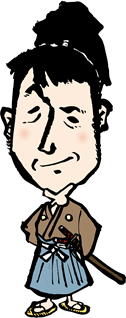I started talking about “West Facing Samurai” a couple of days ago. I will talk about “Samurai” today. If you do not know what I am talking here, please read this first. 一昨日「西[にし]向[む]く侍[さむらい]」の話[はなし]を始[はじ]めました。今日は「侍」について話します。一昨日のブログを読んでいない人は、ここを読んでください。
So far I have explained “West (= nishi)” and “Facing (= muku)”; you now know that “West (=nishi)” refers to February and April. “Facing (= muku)” refers to June and September.
You would guess “samurai” represents November and that is correct. How comes samurai is November? To understand this, you need to know a bit of Japanese writing system. November can be written 十一月 in Japanese. As you might know, Japanese text can be written/published in a vertical way; and then 十一月 can be seen:
十
一
月
The first two kanji looks like 士, right? (even if it does not looks so to you, you’ve got to say “yes” to continue!) This kanji, 士, is indeed read “samurai”. So this kanji represents November!!! Now you know “West Facing Samurai” refers to February, April, June, September and November ☺
昨日までに、「西[にし]」「向[む]く」を説明[せつめい]しました。「西」は2月と4月、「向く」は6月と9月のことです。じゃあ「さむらい」は何でしょうか? ここまでくると「さむらい」は11月のことだと考[かんが]えることができますね。はい、そうです。11月は「さむらい」です。この説明のためには、日本語の漢字[かんじ]についてと、日本語の書き方についてを考えなくちゃいけません。
11月は十一月と書くことができますね。そして、日本語の本や雑誌[ざっし]は、縦[たて]書き(= vertical writing)のものがあります。十一月を縦書きで書くと「十一」は「士」みたいです。そしてこの漢字「士」は、さむらい、と読むことができます。だから、「さむらい」は、11月です! これで「西向く侍」が2月、4月、6月、9月そして11月だとわかりますね☺
